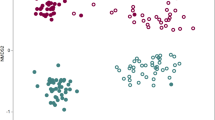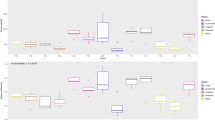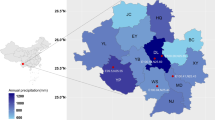Abstract
Soil community responses to increased atmospheric CO2 concentrations are expected to occur mostly through interactions with changing vegetation patterns and plant physiology. To gain insight into the effects of elevated atmospheric CO2 on the composition and functioning of microbial communities in the rhizosphere, Carex arenaria (a non-mycorrhizal plant species) and Festuca rubra (a mycorrhizal plant species) were grown under defined atmospheric conditions with either ambient (350 p.p.m.) or elevated (700 p.p.m.) CO2 concentrations. PCR-DGGE (PCR-denaturing gradient gel electrophoresis) and quantitative-PCR were carried out to analyze, respectively, the structure and abundance of the communities of actinomycetes, Fusarium spp., Trichoderma spp., Pseudomonas spp., Burkholderia spp. and Bacillus spp. Responses of specific functional groups, such as phloroglucinol, phenazine and pyrrolnitrin producers, were also examined by quantitative–PCR, and HPLC (high performance liquid chromatography) was employed to assess changes in exuded sugars in the rhizosphere. Multivariate analysis of group-specific community profiles showed disparate responses to elevated CO2 for the different bacterial and fungal groups examined, and these responses were dependent on plant type and soil nutrient availability. Within the bacterial community, the genera Burkholderia and Pseudomonas, typically known as successful rhizosphere colonizers, were significantly influenced by elevated CO2, whereas the genus Bacillus and actinomycetes, typically more dominant in bulk soil, were not. Total sugar concentrations in the rhizosphere also increased in both plants in response to elevated CO2. The abundances of phloroglucinol-, phenazine- and pyrrolnitrin-producing bacterial communities were also influenced by elevated CO2, as was the abundance of the fungal genera Fusarium and Trichoderma.
Similar content being viewed by others
Log in or create a free account to read this content
Gain free access to this article, as well as selected content from this journal and more on nature.com
or
References
Ainsworth EA, Long SP . (2005). What have we learned from 15 years of free-air CO2 enrichment (FACE)? A meta-analytic review of the responses of photosynthesis, canopy properties and plant production to rising CO2 . New Phytol 165: 351–372.
Allard V, Newton PCD, Lieffering M, Soussana JF, Carran RA, Matthew C . (2005). Increased quantity and quality of coarse soil organic matter fraction at elevated CO2 in a grazed grassland are a consequence of enhanced root growth rate and turnover. Plant Soil 276: 49–60.
Alley R, Berntsen T, Bindoff NL, Chen Z, Chidthaisong A, Friedlingstein PB et al. (2007). Climate change 2007: The Physical Science Basis. Contribution of working group I to the fourth assessment report of the Intergovernmental Panel on Climate Change, Paris.
Bangera MG, Thomashow LS . (1999). Identification and characterization of a gene cluster for synthesis of the polyketide antibiotic 2, 4-diacetylphloroglucinol from Pseudomonas fluorescens Q2-87. J Bacteriol 181: 3155–3163.
Bardgett RD, Kandeler E, Tscherko D, Hobbs PJ, Bezemer TM, Jones TH et al. (1999). Below-ground microbial community development in a high temperature world. Oikos 85: 193–203.
Barron-Gafford G, Martens D, Grieve K, Biel K, Kudeyarov V, McLain JET et al. (2005). Growth of eastern cottonwoods (Populus deltoides) in elevated [CO2] stimulates stand-level respiration and rhizodeposition of carbohydrates, accelerates soil nutrient depletion, yet stimulates above- and belowground biomass production. Glob Chang Biol 11: 1220–1233.
Berg G, Eberl L, Hartmann A . (2005). The rhizosphere as a reservoir for opportunistic human pathogenic bacteria. Environ Microbiol 7: 1673–1685.
Bergsma-Vlami M, Prins ME, Staats M, Raaijmakers JM . (2005). Assessment of genotypic diversity of antibiotic-producing Pseudomonas species in the rhizosphere by denaturing gradient gel electrophoresis. Appl Environ Microbiol 71: 993–1003.
Borcard D, Legendre P, Drapeau P . (1992). Partialling out the spatial component of ecological variation. Ecology 73: 1045–1055.
Cardon ZG . (1996). Influence of rhizodeposition under elevated CO2 on plant nutrition and soil organic matter. Plant Soil 187: 277–288.
Carney KM, Hungate BA, Drake BG, Megonigal JP . (2007). Altered soil microbial community at elevated CO2 leads to loss of soil carbon. Proc Natl Acad Sci USA 104: 4990–4995.
Casgrain P, Legendre P . (2001). The R package for multivariate and spatial analysis. Département de sciences biologiques, Université de Montréal: Montréal, Canada.
Darrah PR . (1996). Rhizodeposition under ambient and elevated CO2 levels. Plant Soil 187: 265–275.
De Souza JT, Raaijmakers JM . (2003). Polymorphisms within the prnD and pltC genes from pyrrolnitrin and pyoluteorin-producing Pseudomonas and Burkholderia spp. FEMS Microbiol Ecol 43: 21–34.
Drigo B, Kowalchuk GA, Yergeau E, Bezemer TM, Boschker HTS, Van Veen JA . (2007). Impact of elevated carbon dioxide on the rhizosphere communities of Carex arenaria and Festuca rubra. Glob Chang Biol 13: 2396–2410.
Duffy B, Keel C, Defago G . (2004). Potential role of pathogen signaling in multitrophic plant-microbe interactions involved in disease protection. Appl Environ Microbiol 70: 1836–1842.
Filion M, Dutilleu P, Potvin C . (2000). Optimum experimental design for Free-Air Carbon dioxide Enrichment (FACE) studies. Glob Chang Biol 6: 843–854.
Frey-Klett P, Garbaye J, Tarkka M . (2007). The mycorrhiza helper bacteria revisited. New Phytol 176: 22–36.
Gamper H, Hartwig UA, Leuchtmann A . (2005). Mycorrhizas improve nitrogen nutrition of Trifolium repens after 8 years of selection under elevated atmospheric CO2 partial pressure. New Phytol 167: 531–542.
Garbeva P, van Veen JA, van Elsas JD . (2003). Predominant Bacillus spp. in agricultural soil under different management regimes detected via PCR-DGGE. Microb Ecol 45: 302–316.
Garbeva P, van Veen JA, van Elsas JD . (2004). Assessment of the diversity, and antagonism towards Rhizoctonia solani AG3, of Pseudomonas species in soil from different agricultural regimes. FEMS Microb Ecol 47: 51–64.
Grayston SJ, Campbell CD, Lutze JL, Gifford RM . (1998). Impact of elevated CO2 on the metabolic diversity of microbial communities in N-limited grass swards. Plant Soil 203: 289–300.
Greipsson S, El-Mayas H . (1999). Large-scale reclamation of barren lands in Iceland by aerial seeding. Land Degrad Dev 10: 185–193.
Griffiths BS, Ritz K, Ebblewhite N, Paterson E, Killham K . (1998). Ryegrass rhizosphere microbial community structure under elevated carbon dioxide concentrations, with observations on wheat rhizosphere. Soil Biol Biochem 30: 315–321.
Hagn A, Wallisch S, Radl V, Charles Munch J, Schloter M . (2007). A new cultivation independent approach to detect and monitor common Trichoderma species in soils. J Microbiol Methods 69: 86–92.
Harman GE, Björkmann T . (1998). Potential and existing uses of Trichoderma and Gliocladium for plant disease control and plant growth enhancement. In: Kubicek CP, Harman GE (eds). Trichoderma and Gliocladium, Enzymes, Biological Control and Commercial Applications, Vol. 2. Taylor and Francis: London.
Heuer H, Krsek M, Baker P, Smalla K, Wellington E . (1997). Analysis of actinomycete communities by specific amplification of genes encoding 16S rRNA and gel-electrophoretic separation in denaturing gradients. Appl Environ Microbiol 63: 3233–3241.
Hodge A, Millard P . (1998). Effect of elevated CO2 on carbon partitioning and exudate release from Plantago lanceolata seedlings. Physiol Plant 103: 280–286.
Hoppener-Ogawa S, Leveau JHJ, van Veen JA, De Boer W . (2009). Mycophagous growth of Collimonas bacteria in natural soils, impact on fungal biomass turnover and interactions with mycophagous Trichoderma fungi. ISME J 3: 190–198.
Jones TH, Thompson LJ, Lawton JH, Bezemer TM, Bardgett RD, Blackburn TM et al. (1998). Impacts of rising atmospheric carbon dioxide on model terrestrial ecosystems. Science 280: 441–443.
Jossi M, Fromin N, Tarnawski S, Kohler F, Gillet F, Aragno M et al. (2006). How elevated pCO2 modifies total and metabolically active bacterial communities in the rhizosphere of two perennial grasses grown under field conditions. FEMS Microbiol Ecol 55: 339–350.
Kandeler E, Tscherko D, Bardgert RD, Hobbs PJ, Kampichler C, Jones TH . (1998). The response of soil micro-organisms and roots to elevated CO2 and temperature in a terrestrial model ecosystem. Plant Soil 202: 251–262.
Keel C, Schnider U, Maurhofer M, Voisard C, Laville J, Burger P et al. (1992). Suppression of root diseases by Pseudomonas fluorescens CHA0: importance of the secondary metabolite 2,4-diacetylphloroglucinol. Mol Plant Microbe Interact 5: 4–13.
Keel C, Weller DM, Natsch A, Defago G, Cook RJ, Thomashow LS . (1996). Conservation of the 2,4-diacetylphloroglucinol biosynthesis locus among fluorescent Pseudomonas strains from diverse geographic locations. Appl Environ Microbiol 62: 552–563.
King JS, Hanson PJ, Bernhardt E, DeAngelis P, Norby RJ, Pregitzer KS . (2004). A multiyear synthesis of soil respiration responses to elevated atmospheric CO2 from four forest FACE experiments. Glob Chang Biol 10: 1027–1042.
Klironomos JN, Allen MF, Rillig MC, Piotrowski J, Makvandi-Nejad S, Wolfe BE et al. (2005). Abrupt rise in atmospheric CO2 overestimates community response in a model plant-soil system. Nature 433: 621–624.
Kowalchuk GA, Buma DS, de Boer W, Klinkhamer PGL, van Veen JA . (2002). Effects of above-ground plant species composition and diversity on the diversity of soil-borne micro-organisms. Antonie Van Leeuwenhoek 81: 509–520.
Kreuzer-Martin HW . (2007). Stable isotope probing: Linking functional activity to specific members of microbial communities. Soil Sci Soc Am J 71: 611–619.
Legendre P, Anderson MJ . (1999). Distance-based redundancy analysis: Testing multispecies responses in multifactorial ecological experiments. Ecol Monogr 69: 1–24.
Lingoes JC . (1971). Some boundary conditions for a monotone analysis of symmetric matrices. Psychometrika 36: 195–203.
Lipson DA, Blair M, Barron-Gafford G, Grieve K, Murthy R . (2006). Relationships between microbial community structure and soil processes under elevated atmospheric carbon dioxide. Microb Ecol 51: 302–314.
Long SP, Ainsworth EA, Rogers A, Ort DR . (2004). Rising atmospheric carbon dioxide: plants face the future. Annu Rev Plant Biol 55: 591–628.
Lueders T, Manefield M, Friedrich MW . (2004). Enhanced sensitivity of DNA- and rRNA-based stable isotope probing by fractionation and quantitative analysis of isopycnic centrifugation gradients. Environ Microbiol 6: 73–78.
Lugtenberg BJJ, Dekkers L, Bloemberg GV . (2001). Molecular determinant of rhizosphere colonization by Pseudomonas. Annu Rev Phytopathol 39: 461–490.
Lynch JM, Whipps JM . (1990). Substrate flow in the rhizosphere. Plant Soil 129: 1.
Marilley L, Hartwig UA, Aragno M . (1999). Influence of an elevated atmospheric CO2 content on soil and rhizosphere bacterial communities beneath Lolium perenne and Trifolium repens under field conditions. Microb Ecol 38: 39–49.
Matamala R, Gonzalez-Meler MA, Jastrow JD, Norby RJ, Schlesinger WH . (2003). Impacts of fine root turnover on forest NPP and soil C sequestration potential. Science 302: 1385–1387.
Montealegre CM, van Kessel C, Blumenthal JM, Hur HG, Hartwig UA, Sadowsky MJ . (2000). Elevated atmospheric CO2 alters microbial population structure in a pasture ecosystem. Glob Chang Biol 6: 475–482.
Montealegre CM, van Kessel C, Russelle MP, Sadowsky MJ . (2002). Changes in microbial activity and composition in a pasture ecosystem exposed to elevated atmospheric carbon dioxide. Plant Soil 243: 197–207.
Muchovej JJ, Muchovej RMC, Gonçalves EJ . (1991). Effect of kind and method of fungicidal treatment of bean seed on infections by the VA-mycorrhizal fungus Glomus macrocarpum and by the pathogenic fungus Fusarium solani. Plant Soil 132: 47–51.
Muyzer G, de Waal EC, Uitterlinden AG . (1993). Profiling of complex microbial populations by denaturing gradient gel electrophoresis analysis of polymerase chain reaction-amplified genes coding for 16S rRNA. Appl Environ Microbiol 59: 695–700.
Nguyen C . (2003). Rhizodeposition of organic C by plants: mechanisms and controls. Agronomie 23: 375–396.
Olsson PA, Johnson NC . (2005). Tracking carbon from the atmosphere to the rhizosphere. Ecol Lett 8: 1264–1270.
Orlowska E, Ryszka P, Jurkiewicz A, Turnau K . (2005). Effectiveness of arbuscular mycorrhizal fungal (AMF) strains in colonization of plants involved in phytostabilisation of zinc wastes. Geoderma 129: 92–98.
Paterson E, Rattray EA, Killham K . (1996). Effect of elevated atmospheric CO2 concentration on C-partitioning and rhizosphere C-flow for three plant species. Soil Biol Biochem 28: 195.
Philips DA, Fox TC, Six J . (2006). Root exudation (net efflux of amino acids) may increase rhizodeposition under elevated CO2 . Glob Chang Biol 12: 561–567.
Phillips RP . (2007). Towards a rhizo-centric view of plant-microbial feedbacks under elevated atmospheric CO2 . New Phytol 173: 664–667.
Raaijmakers JM, Weller DM, Thomashow LS . (1997). Frequency of antibiotic-producing Pseudomonas spp. in natural environments. Appl Environ Microbiol 63: 881–887.
Raaijmakers JM, Vlami M, de Souza JT . (2002). Antibiotic production by bacterial biocontrol agents. Antoine Van Leeuwenhoek 81: 537–547.
Roesch LF, Fulthorpe RR, Riva A, Casella G, Hadwin AKM, Kent AD et al. (2007). Pyrosequencing enumerates and contrasts soil microbial diversity. ISME J 1: 283–290.
Rogers HH, Runion GB, Krupa SV . (1994). Plant-Responses to atmospheric CO2 enrichment with emphasis on roots and the rhizosphere. Environ Pollut 83: 155–189.
Salles JF, de Souza FA, van Elsas JD . (2002). Molecular method to assess the diversity of Burkholderia species in environmental samples. Appl Environ Microbiol 68: 1595–1603.
Schortemeyer M, Hartwig UA, Hendrey GR, Sadowsky MJ . (1996). Microbial community changes in the rhizospheres of white clover and perennial ryegrass exposed to Free Air Carbon dioxide Enrichment (FACE). Soil Biol Biochem 28: 1717–1724.
Smalla K, Wieland G, Buchner A, Zock A, Parzy J, Kaiser S et al. (2001). Bulk and rhizosphere soil bacterial communities studied by denaturing gradient gel electrophoresis: Plant-dependent enrichment and seasonal shifts revealed. Appl Environ Microbiol 67: 4742–4751.
Smith SE, Read DJ . (1997). Mycorrhizal Symbiosis. Academic Press: San Diego.
Stipanovic RD, Williams HJ, Sattler I, Scott AI, Liu J . (1998). Preparation of two stereochemically defined isomers of deuterium labelled d-cadinene. J Labelled Comp Radiopharm 39: 223–230.
Tarnawski S, Aragno M . (2006). The influence of elevated CO2 on diversity, activity and biogeochemical function of rhizosphere and soil bacterial communities. In: Nösberger J, Long SP, Norby RJ et al. (eds). Managed Ecosystems and CO2—Case Studies, Processes and Perspectives. Ecological Studies Serie, Vol. 187. Springer: Berlin, Heidelberg, pp 393–409.
Tarnawski S, Hamelin J, Jossi M, Aragno M, Fromin N . (2006). Phenotypic structure of Pseudomonas populations is altered under elevated pCO2 in the rhizosphere of perennial grasses. Soil Biol Biochem 38: 1193.
Ter Braak CJF, Šmilauer P . (2002). CANOCO reference manual and CanoDraw for Windows user's guide: software for canonical community ordination (version 4.5). Microcomputer Power: Ithaca, NY.
Ter Braak CJF, Verdonschot P . (1995). Canonical correspondence analysis and related multivariate methods in aquatic ecology. Aquat Sci 57: 255–289.
Treonis AM, Ostle NJ, Stott AW, Primrose R, Grayston SJ, Ineson P . (2004). Identification of groups of metabolically-active rhizosphere micro-organisms by stable isotope probing of PLFAs. Soil Biol Biochem 36: 533–537.
Vancanneyt M, Witt S, Abraham WR, Kersters K, Fredrickson HL . (1996). Fatty acid content in whole-cell hydrolysates and phospholipid fractions of pseudomonads: A taxonomic evaluation. Syst Appl Microbiol 19: 528–540.
Widmer F, Seidler RJ, Gillevet PM, Watrud LS, Di Giovanni GD . (1998). A highly selective PCR protocol for detecting 16S rRNA genes of the genus Pseudomonas (sensu stricto) in environmental samples. Appl Environ Microbiol 64: 2545–2553.
Yergeau E, Filion M, Vujanovic V, St-Arnaud M . (2005). A PCR-denaturing gradient gel electrophoresis approach to assess Fusarium diversity in asparagus. J Microbiol Methods 60: 143–154.
Zak DR, Ringelberg DB, Pregitzer KS, Randlett DL, White DC, Curtis PS . (1996). Soil microbial communities beneath Populus grandidentata crown under elevated atmospheric CO2 . Ecol Applic 6: 257–262.
Acknowledgements
This study was supported by a Netherlands Research Council (NWO) grant of the Biodiversity and Global Change program (852.00.40). The authors thank Roel Wagenaar, Felix Waeckers and Wim van der Putten for expert input regarding sugar analyses, as well as critical comments toward the content of the paper. We extend our gratitude to Sachie Hoppener-Ogawa, Maria Bersma-Vlami and Jos Raaijmakers for providing strains used in this study. This is a NIOO-KNAW publication 4560.
Author information
Authors and Affiliations
Corresponding author
Additional information
Supplementary Information accompanies the paper on The ISME Journal website (http://www.nature.com/ismej)
Supplementary information
Rights and permissions
About this article
Cite this article
Drigo, B., van Veen, J. & Kowalchuk, G. Specific rhizosphere bacterial and fungal groups respond differently to elevated atmospheric CO2. ISME J 3, 1204–1217 (2009). https://doi.org/10.1038/ismej.2009.65
Received:
Revised:
Accepted:
Published:
Issue date:
DOI: https://doi.org/10.1038/ismej.2009.65
Keywords
This article is cited by
-
Effect of the use of biocontrol agents and resistance inducers against race 1 of Fusarium oxysporum f. sp. lactucae on lettuce in a simulated climate change scenario
Journal of Plant Pathology (2023)
-
Effect of atmospheric CO2 on plant defense against leaf and root pathogens of Arabidopsis
European Journal of Plant Pathology (2019)
-
Suppression of Phytophthora blight of pepper by biochar amendment is associated with improved soil bacterial properties
Biology and Fertility of Soils (2019)
-
Vanillic acid changed cucumber (Cucumis sativus L.) seedling rhizosphere total bacterial, Pseudomonas and Bacillus spp. communities
Scientific Reports (2018)



